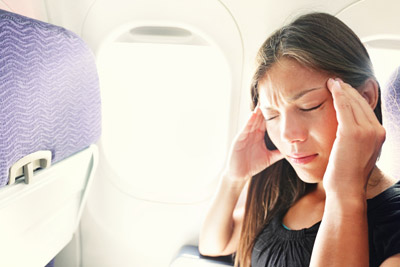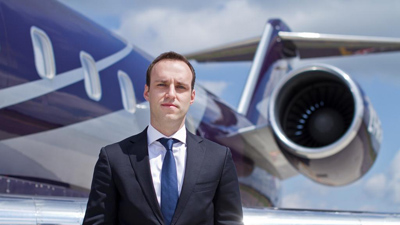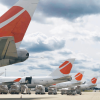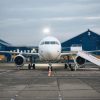 According to IATA Passenger Forecast, by 2034 the number of air travellers worldwide is expected to double and reach more than 6 billion per year. However, regardless of our increasing confidence in aviation technology and a growing dependence on air travelling solutions, there is still a sizeable portion of people who feel real discomfort as soon as they step on-board. So what are the reasons behind the fact that for some of us flying may still associate with the worst nightmare? Can such factors as interior colours, design features and entertainment systems influence our comfort during the flight?
According to IATA Passenger Forecast, by 2034 the number of air travellers worldwide is expected to double and reach more than 6 billion per year. However, regardless of our increasing confidence in aviation technology and a growing dependence on air travelling solutions, there is still a sizeable portion of people who feel real discomfort as soon as they step on-board. So what are the reasons behind the fact that for some of us flying may still associate with the worst nightmare? Can such factors as interior colours, design features and entertainment systems influence our comfort during the flight?
Based on multiple surveys, one of the top factors which commonly compromises our ability to relax on an aircraft is other passengers sitting nearby. Already in the late 19th century Gustave Le Bon observed humans in crowds acting in accordance to the so called “herd behaviour”. We all tend to act the same way without a clear direction when we find ourselves in large groups. With that in mind, no wonder that it may be nearly impossible to loosen up whilst on-board, where anyone of the 200 people may start acting out or showing clear signs of panic. By the way, this is more common than you might think, as the number of such cases topped 8000 in 2013 alone (acc. to IATA). And there are numerous reasons why people get agitated on planes, including stress, fear, anxiety or even anger. Regardless of the nature of distress, the state and the reaction that follows can often easily spread to other passengers.
Furthermore, such common hassles as waiting in long queues at the airport, overcrowded aircraft and sitting next to a stranger – it can all add up to a very unpleasant experience. Probably that’s why airlines were ranked so low in the 2014 American Consumer Satisfaction Index (ACSI), only a tad higher than local and federal governments as well as annoying internet and TV providers only. Meanwhile, in contrast to commercial carriers which seem be incapable of reducing the stress of their passengers, private aviation has long been the industry with exclusive focus on their consumers’ needs.
“Business aviation is what people choose when they opt for an exquisite and undisturbed experience. Nothing is as important as the passengers’ safety and utmost comfort. Such design gurus as Donatello Versace or BRABUS have contributed to the process of designing private jets to match every possible need and ensure maximum customer satisfaction. Prompted by the increasing demand and appreciation of private flying, even such industry giants as Airbus and Boeing are jumping in by establishing their private jet divisions. It is a clear sign that exquisite interiors, entertainment services and more are now a must to ensure maximum comfort and a positive feeling on-board. And that’s the area where business aviation excels in,” explains Vitalij Kapitonov, the CEO of KlasJet.
Such design gurus as Donatello Versace or BRABUS have contributed to the process of designing private jets to match every possible need and ensure maximum customer satisfaction. Prompted by the increasing demand and appreciation of private flying, even such industry giants as Airbus and Boeing are jumping in by establishing their private jet divisions. It is a clear sign that exquisite interiors, entertainment services and more are now a must to ensure maximum comfort and a positive feeling on-board. And that’s the area where business aviation excels in,” explains Vitalij Kapitonov, the CEO of KlasJet.
In the meantime, while business aviation seems to be finding ways to eliminate passenger anxiety, commercial carriers are still struggling. The most recent survey by YouGov and the Economist has unveiled that the number of US citizens who aren't afraid to fly fell to its lowest point (41 %) in 30 years since the Germanwings tragedy in the French Alps. Nonetheless, according to psychologists, many of these anxieties and fears could be eliminated by the correct use of colours, design features and entertainment systems, ensuring the utmost comfort for every passenger.
One of the mostly noted origins of fear is the unfamiliar sounds heard when on-board an aircraft. Despite this presumption, a study by the Carl von Ossietzky University of Oldenburg has found that in 73.3 % of all cases airline passengers select low, pleasant loudness as the most important attribute of a flight deemed as comfortable. In addition, multiple psychological theories suggest that other senses also play a significant role in the overall enjoyment of the flight.
For instance, our sight may also influence our flight experience. Dr. Toby Israel, an expert in design psychology, suggests that psychological impact of visual design stimuli can have a perceptible physical effect on aircraft passengers. In fact, even such factors as colour schemes can play games with passengers’ minds. For example, it has been found that a traveller can find himself feeling cold in cool-toned areas, such as blue or purple, whereas warm-toned rooms can create an opposite effect, even though the temperatures might be exactly the same. This is astounding when you take into consideration how differently distinct commercial carriers choose to arrange their interiors.
“Despite the fact that the commercial industry has acknowledged the issue with the recent news about American Airline plans to invest over $2 billion in customer improvements, it is still lagging far behind,” states Vitalij Kapitonov, the CEO of KlasJet. “Private jets have always been designed according to clients’ needs with no resources spared when it comes to making flights as pleasant as possible. According to GoGo, besides safety, entertainment services are cited as the most critical by private travellers. Business aviation is in full understanding of such needs and no factor is compromised in favour of another. Being aware of the customers’ needs and ensuring utmost comfortable environment with unique design and all-round service are the elements that travellers are after nowadays. And no one would dare say that in terms of these elements business aviation is below 100%”.





